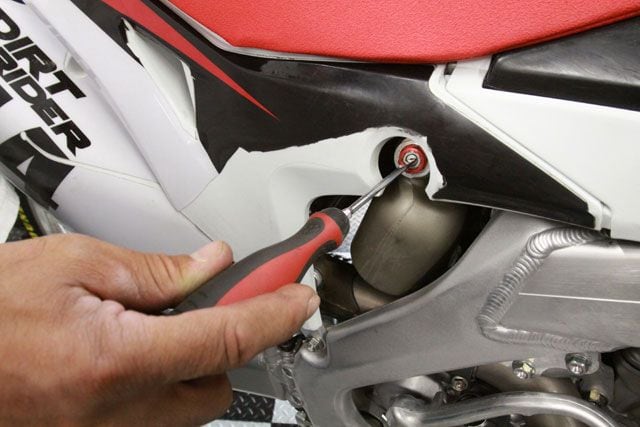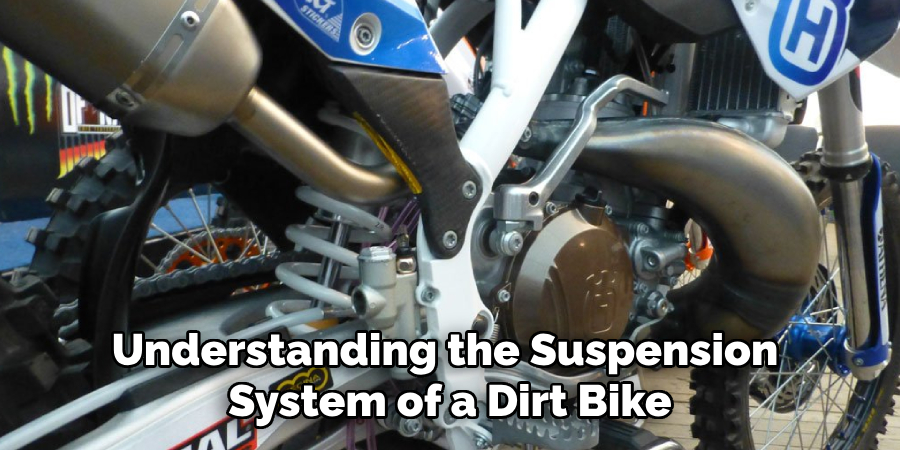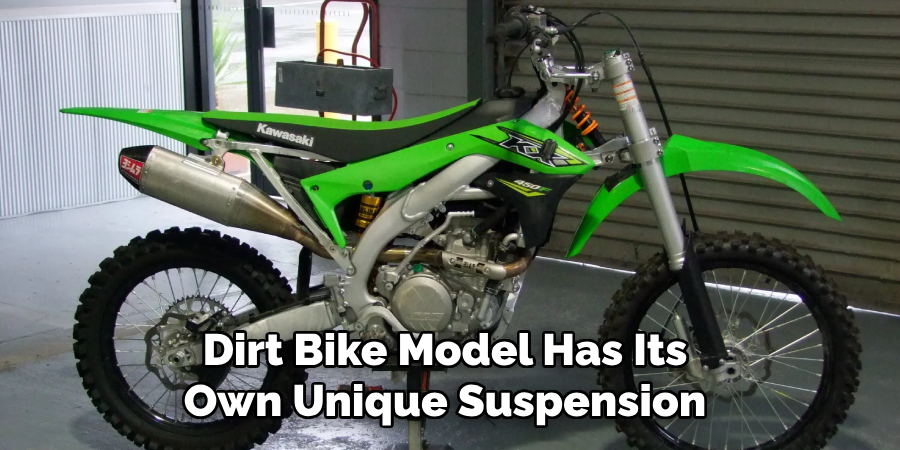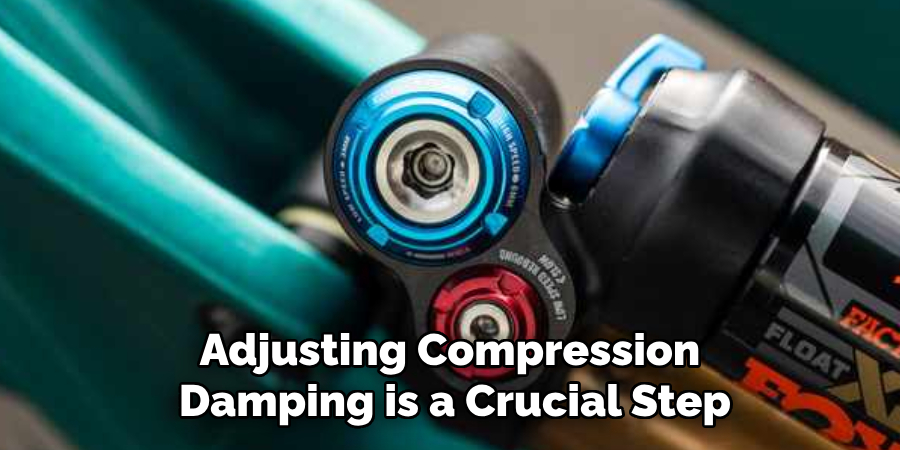To adjust the suspension on a dirt bike, measure sag, adjust compression and rebound settings, and fine-tune for optimal performance. Intro: Dirt bikes are a popular choice for off-road enthusiasts, offering an exhilarating riding experience.
However, to get the most out of your dirt bike, it’s crucial to have the suspension properly adjusted. The suspension plays a critical role in maintaining stability, handling, and overall comfort while riding. In this guide, we will provide a step-by-step explanation of how to adjust the suspension on your dirt bike, ensuring that you can ride with confidence and control.
Whether you’re a seasoned rider or a beginner, these adjustments will help you optimize your bike’s performance on any terrain. So, let’s dive in and explore the process of adjusting the suspension to enhance your dirt bike riding experience.

Credit: www.dirtrider.com
Why Suspension Adjustment Matters
The proper adjustment of suspension on a dirt bike is crucial for optimal performance and safety. The suspension system works as a critical link between the rider and the bike, absorbing impacts and providing stability and control. It is essential to understand the importance of setting up the suspension correctly to maximize its effectiveness.
When the suspension is not properly adjusted, it can lead to various negative effects on the dirt bike’s performance. Incorrect settings may result in a harsh and uncomfortable ride, reduced traction, poor handling, and instability while riding over different terrains. It can also affect the bike’s ability to absorb impacts, increasing the risk of bottoming out or excessive bouncing.
By maintaining the correct sag, compression, and rebound settings, riders can improve their overall riding experience. It enables the suspension to work in harmony with the bike, providing better control, stability, and responsiveness. A well-adjusted suspension allows riders to tackle various obstacles and terrains with confidence and enhances the bike’s overall performance.
| Effects of Incorrect Suspension Settings |
|---|
| 1. Harsh and uncomfortable ride |
| 2. Reduced traction and poor handling |
| 3. Instability over different terrains |
| 4. Increased risk of bottoming out |
| 5. Excessive bouncing |
Understanding Dirt Bike Suspension
Understanding the suspension system of a dirt bike is crucial for adjusting it effectively. The basic components of a dirt bike’s suspension system include the forks, which are located at the front, and the rear shock, located near the back wheel.

The suspension works by absorbing impacts and maintaining control. When you encounter bumps or jumps while riding, the forks and rear shock compress, absorbing the force and minimizing the impact on your body and bike. This helps to keep the wheels in contact with the ground, ensuring better stability and traction.
The compression and rebound settings of the suspension can be adjusted to suit your riding style, weight, and the terrain you’re riding on. By adjusting the suspension, you can improve the bike’s handling, stability, and comfort.
Determining The Ideal Suspension Settings
Determining the Ideal Suspension Settings
Factors to consider when adjusting suspension:
- Rider weight and style: One of the crucial aspects to consider when adjusting suspension is the weight and riding style of the rider. A heavier rider may require stiffer suspension settings to maintain stability and prevent bottoming out, while a lighter rider may need softer settings to ensure a smoother ride.
- Riding terrain and conditions: The type of terrain you ride on plays a significant role in determining the ideal suspension settings. Rough and rocky trails demand firmer settings to handle the impact, whereas smoother tracks may benefit from softer settings to maximize comfort and traction.
- Bike model and setup: Every dirt bike model has its own unique suspension characteristics. Understanding your bike’s capabilities and adjusting the suspension accordingly can improve handling and overall performance. Additionally, modifications such as changing springs or adjusting pre-load can fine-tune the suspension to suit your preferences.

How to Adjust Suspension on Dirt Bike: Step by Step Guide
Setting The Sag
A proper adjustment of suspension on a dirt bike is crucial for a smooth and controlled ride. One key aspect of suspension setup is setting the sag, which refers to the amount the suspension compresses under the weight of the rider.
The sag setting affects the bike’s handling, stability, and overall performance. To adjust sag on a dirt bike, follow these steps:
| Step | Actions |
|---|---|
| 1 | Measure the sag by having someone support the bike upright and measuring the distance between specific points on the suspension. |
| 2 | Compare the measured sag to the manufacturer’s recommended sag setting for your bike model. Consult the owner’s manual or contact the manufacturer if necessary. |
| 3 | If the sag is too low, you need to increase it by adjusting the preload. This involves turning the preload adjuster clockwise to increase tension on the spring. |
| 4 | If the sag is too high, you need to decrease it by adjusting the preload. Turn the preload adjuster counterclockwise to reduce tension on the spring. |
| 5 | Make gradual adjustments and remeasure the sag after each adjustment until you achieve the recommended setting. |
| 6 | Remember to take into account rider gear and equipment weight when setting the sag. |
Setting the sag correctly is essential for obtaining optimal suspension performance on a dirt bike. Follow these steps carefully to ensure a comfortable and responsive ride.
Adjusting Compression Damping
Adjusting compression damping is a crucial step in fine-tuning the suspension of your dirt bike. Compression damping refers to the resistance the suspension provides when it compresses due to the impact of bumps and jumps. Understanding compression damping and its impact on your bike’s performance is essential to achieve optimal handling and control.

Here is a step-by-step guide to adjusting compression damping settings:
- Start by locating the compression damping adjuster on your dirt bike’s suspension. This adjuster is typically located at the top of the fork leg or on the shock body.
- Refer to your dirt bike’s owner’s manual or the manufacturer’s guidelines to determine the recommended compression damping settings for your specific riding conditions.
- Using a suitable tool, turn the adjuster clockwise to increase compression damping or counterclockwise to decrease it. Make incremental adjustments to find the optimal setting.
- Test ride your dirt bike on various terrain and monitor its performance. Pay attention to how the suspension responds to bumps and jumps.
- If the suspension feels too stiff, reducing the compression damping can help provide a smoother and more comfortable ride. Conversely, increasing compression damping can improve stability and control if the suspension feels too soft.
- Continue fine-tuning the compression damping settings until you achieve the desired balance between comfort, stability, and performance.

By understanding compression damping and following this step-by-step guide, you can effectively adjust the suspension of your dirt bike and optimize its performance for your riding style and conditions.
Tweaking Rebound Damping
Rebound damping plays a crucial role in the overall suspension performance of a dirt bike. It refers to the ability of the suspension to control the speed at which it extends after compressing. Proper adjustment of rebound damping is essential to maintain control, stability, and traction of the bike.
When rebound damping is set too low, the suspension rebounds too quickly, causing the bike to feel unsettled and unstable. On the other hand, if it is set too high, the suspension extends too slowly, resulting in a harsh and uncomfortable ride. It’s important to find the right balance for optimal performance.
To adjust rebound damping, start by locating the rebound adjuster on your bike’s forks or shock absorber. Turn it clockwise to increase damping and slow down the extension, or turn it counterclockwise to decrease damping and allow for faster extension. Make small adjustments and test the bike’s behavior after each change.
Keep in mind that the ideal rebound damping setting may vary depending on factors like rider weight, riding style, and terrain. Experimentation and fine-tuning are key to finding the perfect suspension setup for your dirt bike.
Finding The Right Preload Setting
Adjusting the suspension on your dirt bike is crucial for rider comfort and improved bike handling. A key aspect of suspension adjustment is finding the right preload setting. The preload adjustment determines the initial compression of the suspension spring, affecting how the bike reacts to bumps and impacts.
To set the correct preload on your dirt bike suspension, follow these step-by-step instructions:
- Start by noting down the initial measurements of the sag, which is the distance the rear suspension compresses when you sit on the bike.
- Use the preload adjustment collar or lock rings on your suspension to increase or decrease the spring tension.
- Make small adjustments and test the suspension after each change to feel the difference in rider comfort and bike handling.
- Keep in mind that a softer preload setting provides a smoother ride, while a firmer setting offers better stability and control.
- Find the right balance that suits your riding style and terrain preferences.
- Regularly check and adjust the preload setting as needed, especially when experiencing changes in riding conditions.
By following these guidelines, you can fine-tune your dirt bike suspension’s preload setting and optimize your riding experience.
Making Additional Adjustments
Understanding the different adjusters on your dirt bike’s suspension is crucial for optimal performance on various terrains. Each adjuster serves a specific purpose to fine-tune your bike’s suspension and ensure a comfortable and controlled ride.
The compression adjuster regulates how quickly the suspension compresses during compression forces like jumps or hard landings. By adjusting this, you can optimize your bike’s stability and prevent bottoming out.
On the other hand, the rebound adjuster controls the speed at which the suspension extends after a compression event. It determines how quickly your bike rebounds after a jump or bump, ensuring better traction and minimizing the risk of losing control.
For specific riding conditions, such as soft or hard terrain, you may need to make small adjustments to achieve the desired performance. Experiment with different settings to find the perfect balance that suits your riding style and preference.
Remember, making incremental changes is essential to avoid drastic and potentially dangerous alterations to your suspension setup. Keep track of the adjustments you make, noting the effects on your bike’s handling, and refine your settings until you achieve optimal performance.
Test And Refine
Adjusting the suspension on your dirt bike is crucial for achieving the best performance on various terrains. It is essential to test and refine the adjustments to ensure optimal results. Proper testing allows you to assess how the suspension performs in different conditions, such as rough trails, jumps, or corners.
The process of fine-tuning suspension settings is iterative. By making small adjustments and testing them, you can gradually optimize the bike’s performance. Pay attention to factors like compression and rebound damping, preload, and sag. Each adjustment affects how the bike responds to bumps, jumps, and turns.
Testing the adjustments on a range of terrains will help you understand how the bike behaves in different scenarios. This knowledge is valuable for achieving maximum comfort, control, and stability, enhancing your riding experience.
Seeking Professional Help
Seeking professional help for suspension tuning and adjustments is essential in certain situations. While many riders may be able to handle basic adjustments themselves, there are times when the expertise of a professional can greatly benefit your dirt bike’s performance.
Knowing when to consult a professional is important. If you’re a beginner rider or lack experience in suspension tuning, it’s recommended to seek professional assistance. Additionally, if you’re facing persistent issues with your bike’s suspension, such as excessive bouncing or instability, it may be time to turn to the professionals.
One of the key advantages of professional suspension setup and customization is the level of expertise they bring. These professionals have extensive knowledge and experience in understanding the intricacies of suspension systems. They can provide precise adjustments tailored to your specific needs, maximizing your bike’s performance and ensuring a comfortable ride.
Furthermore, professional suspension services often utilize advanced technologies and specialized tools for accurate tuning. They have access to a wide range of suspension components and can recommend upgrades that will enhance your bike’s handling and overall performance.
To summarize, while basic suspension adjustments can be done by riders themselves, seeking professional help can offer numerous benefits. Their expertise, specialized tools, and customized adjustments can significantly improve your dirt bike’s suspension performance and overall riding experience.
Maintenance And Periodic Inspection
Routine maintenance tasks are crucial for keeping your dirt bike suspension in top condition. Regularly inspecting and adjusting the suspension will help identify wear and potential issues before they become major problems. Here are some important maintenance tasks to consider:
- Check the suspension components: Look for any signs of damage, such as leaks or bent parts. Ensure all bolts and fasteners are tight.
- Clean and lubricate: Clean the suspension components, removing any dirt or debris. Apply lubrication to the necessary parts to ensure smooth operation.
- Sag measurement: Set the sag according to your riding style and weight. Adjust the preload to achieve the recommended sag measurement.
- Rebound and compression settings: Evaluate the rebound and compression settings to match your terrain and preference. Make small adjustments to find the optimal settings for your riding style.
- Inspect seals and bushings: Regularly check the seals and bushings for signs of wear. Replace any damaged components to maintain proper suspension performance.
- Fluid maintenance: Periodically change the suspension fluid according to the manufacturer’s recommendations. This helps maintain consistent performance and prevents fluid contamination.
Frequently Asked Questions For How To Adjust Suspension On Dirt Bike
How Do I Adjust The Suspension On My Dirt Bike?
To adjust the suspension on your dirt bike, locate the suspension bolts and adjust them according to your desired settings. It’s important to consider your weight, riding style, and terrain to achieve the desired balance and performance.
Why Is Suspension Adjustment Important For A Dirt Bike?
Suspension adjustment is crucial for a dirt bike as it affects the bike’s stability, handling, and comfort. By tuning the suspension, you can optimize the bike’s performance for different terrains and riding conditions, enhancing both safety and overall riding experience.
What Are The Signs That My Dirt Bike Suspension Needs Adjustment?
If you experience excessive bouncing, bottoming out, or inconsistent handling, it’s a sign that your dirt bike suspension needs adjustment. It could indicate incorrect settings, worn-out components, or changes in riding conditions. Proper suspension adjustment can help address these issues and restore optimal performance.
Conclusion
Adjusting the suspension on your dirt bike is crucial for a smooth and controlled ride. By following the steps outlined in this guide, you can achieve the perfect balance of comfort and performance. Remember to consider your riding style, terrain, and weight when making adjustments.
Regularly inspect and fine-tune your suspension to ensure optimal performance and safety. With a well-adjusted suspension, you can conquer any off-road adventure with confidence and ease.

